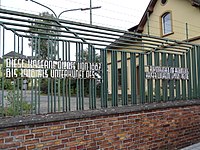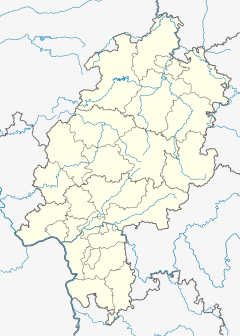Berg-Kaserne (Giessen)
| Gießen mountain barracks | |||
|---|---|---|---|

Demarcation of the former barracks |
|||
| local community | to water | ||
| Coordinates : | 50 ° 35 ' N , 8 ° 42' E | ||
| Opened | 1885 to 1887 | ||
| owner | Federal Republic of Germany | ||
| Old barracks names | |||
| 1887-1918 1919-1933 1933-1945 |
New barracks Berg-Kaserne Berg-Kaserne |
|
|
| Formerly stationed units | |||
|
Infantry Regiment "Kaiser Wilhelm" (Grand Ducal Hessian) No. 116 Infantry Regiment 15 Infantry Regiment 116 Machine Gun Battalion 2 Repair Battalion 5 Federal Armed Forces College Gießen Defense District Command 47 Army Music Corps 5 Homeland Security Battalion 56 |
|
||
|
Location of the mountain barracks in Giessen in Hesse |
|||
The Berg-Kaserne Gießen was located on the eastern outskirts of the city center between Licher Strasse and Grünberger Strasse and covered an area of approx. 10 hectares .
The military facility was initially built as the "New Barracks" between 1885 and 1887 to accommodate the 2nd Hessian Infantry Regiment No. 116 on the Kugelberg in Gießen. The first extensions followed in 1897 and 1913. Among other things, they were used to house a machine gun company . The size of the garrison grew from 1200 to 1800 soldiers .
After the First World War, the Versailles Treaty significantly reduced the number of troops in the barracks to 450 soldiers. The 15th Reichswehr Infantry Regiment was stationed in the Berg barracks . Nevertheless, an expansion took place in 1927, which in particular included a sanitary building, which was used as such until 2006.
Under National Socialist rule, the Gießen mountain barracks was expanded in 1935. In 1934 the 116th Infantry Regiment had already been re-established in the Berg barracks. In 1935 the machine gun battalion 2 was added. Both units were destroyed in World War II . In 1939 the troop strength had increased again to 1,500 soldiers in the mountain barracks. In the same year, six pointed bunkers were completed on the barracks site.
At the entrance to the Berg barracks, the Giessen artist Carl Boucard created a relief in 1938 with a group of soldiers in a martial posture and idealized scenes from the life of the rural population. The relief was later used as a typical example of the artistic representation of the blood and soil of the Nazis as "historic important document" under monument protection provided. The preservation of this work is controversial.
In the Second World War, the Berg barracks was almost completely destroyed.
After the end of the Second World War, US occupation troops occupied parts of the barracks. Parts of the university children's clinic were also housed here.
From September 1952 to September 1958, the Gießen local branch of the technical relief organization was located in the mountain barracks .
Between 1954 and 1957, preparatory work for the entry of the Bundeswehr took place in the mountain barracks . In 1958, in the course of the formation of the Bundeswehr, the repair battalion 5 of the 5th Panzer Division was formed and its partial accommodation in the mountain barracks in Giessen.
In 1960 the Bundeswehr technical college in Giessen was housed in the mountain barracks.
In the 1970s a telecommunication center was set up in the Berg barracks.
The Defense District Command (VBK) 47, in contrast to the VBK 41 to 46 established in 1963, was only set up on April 1, 1982 and housed in the Berg barracks in Gießen with other units subordinate to the VBK.
After the 5th Panzer Division subordinated Army Music Corps 5 in Koblenz to the III. Corps had been assigned directly and was renamed Army Music Corps 300, on October 1, 1985, Army Music Corps 5 was reorganized in Giessen with a new home in the Berg barracks. At the end of 1989 a practice room was set up in the barracks.
The end of the Cold War also brought changes to the Berg barracks in Gießen: On March 31, 1993, Army Music Corps 5 in Gießen was disbanded. The repair battalion 5 was decommissioned on September 30, 1993. Before the Steuben barracks closed in 1993, some of the units stationed there were relocated to the Berg barracks, such as Jägerbataillon 56, which was reclassified to Homeland Security Battalion 56 on October 1, 1992 and subordinated to Defense District Command 47.
The Bundeswehr technical college in Giessen was closed on June 30, 2002. After the plans to abandon the training facility became known, several petitions were directed to the Armed Forces Commissioner . The Jäger Battalion 56 was disbanded on May 30, 2006. With the closing roll call on June 28, 2006, Defense District Command 47 was dissolved and the mountain barracks in Gießen closed.
In November 2007 it was reported that the main customs office is to move into part of the barracks . After renovation of the building, 100 customs officers took over the offices in 2011.
After preliminary coordination between the city of Gießen and the federal government in 2006, a feasibility study in 2007 and the installation procedure, the city of Gießen decided in 2012 a first, project-related development plan GI 03/04 “Bergkaserne I”, which included the construction of a foodstuff on part of the barracks site - and a beverage market as well as two larger residential buildings with underground parking.
A year later, the city of Gießen issued the project-related development plan GI 03/15 "Bergkaserne II", with which the construction of three further residential complexes should be implemented.
With the last development plan GI 03/16 “Bergkaserne III” drawn up by the city of Gießen in 2014, additional areas were designated for residential development and as a mixed area. In addition, the parts left to the main customs office were secured for use by administrations.
Web links
Individual evidence
- ↑ a b c d e f g h City tour to the mountain barracks: From the Kaiser to the Chancellor In: Gießener Allgemeine , May 20, 2014. Retrieved on February 20, 2017.
- ↑ a b Harun Atmaca: The Last Appeal In: Gießener Stadtanzeiger , July 2, 2016, accessed on February 20, 2017.
- ^ Chronicle of Heimatschutzbataillon 56 ( Memento from February 19, 2017 in the Internet Archive )
- ^ Article in the Gießener Allgemeine from October 4, 2012: Artwork from the Nazi era smeared
- ↑ Justification for the project and development plan GI 03/15 "Bergkaserne II"
- ^ Chronicle of THW Giessen
- ↑ 5th Panzer Division (Army Structure 4)
- ↑ a b VBK - VKK Rheinland-Pfalz + Hessen (Army Structure 4) ( Memento from February 20, 2017 in the Internet Archive )
- ↑ List of the Territorial Defense Staff "IV C" of the Bundeswehr for the administrative districts of Wiesbaden and Darmstadt, May 1, 1958. Contemporary history in Hesse. In: Landesgeschichtliches Informationssystem Hessen (LAGIS).
- ↑ 5th Panzer Division (Army Structure 4)
- ↑ Chronicle of the Jägerbataillon 56, pdf ( page no longer available , search in web archives )
- ↑ Briefing by the Defense Commissioner of the Dt. Bundestag, Bundestag printed paper 14/8330 of March 12, 2002, p. 22
- ↑ 5th Panzer Division (Army Structure 4)
- ^ Article from November 21, 2007 in Gießener Allgemeine: Main customs office is to take over former barracks buildings
- ^ Report in Gießener Allgemeine: Soldiers are followed by 100 customs officers from 7 July 2011
- ↑ Justification for the project and development plan "Living and trading on the Kugelberg"
- ↑ Justification for the project and development plan GI 03/15 "Bergkaserne II"
- ↑ Summary declaration according to § 10 Abs. 4 BauGB for the development plan GI 03/16 Bergkaserne III


